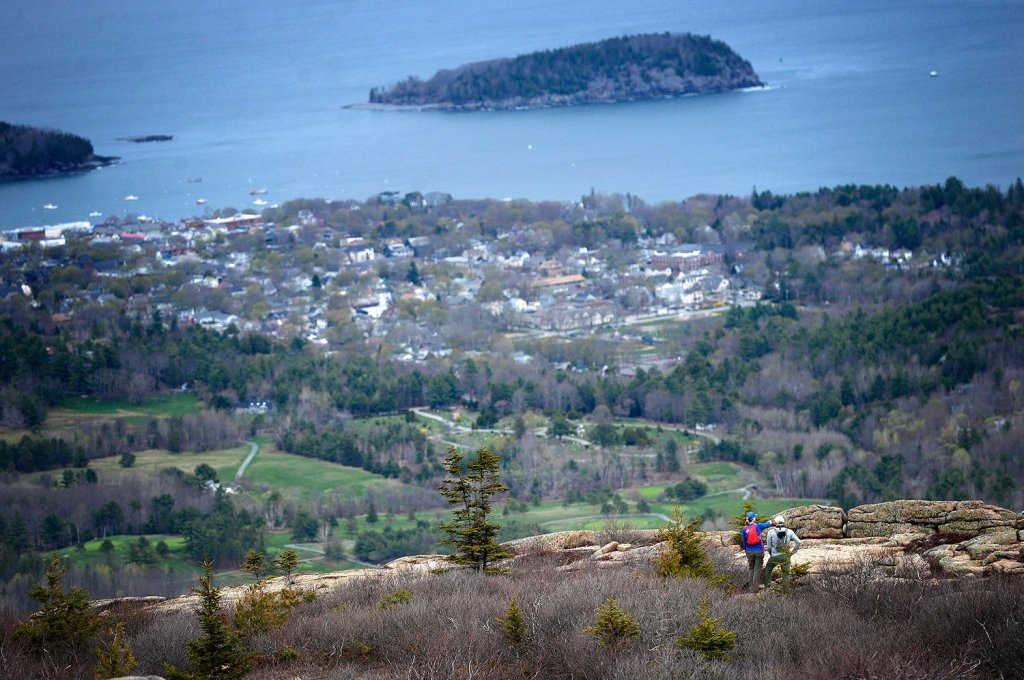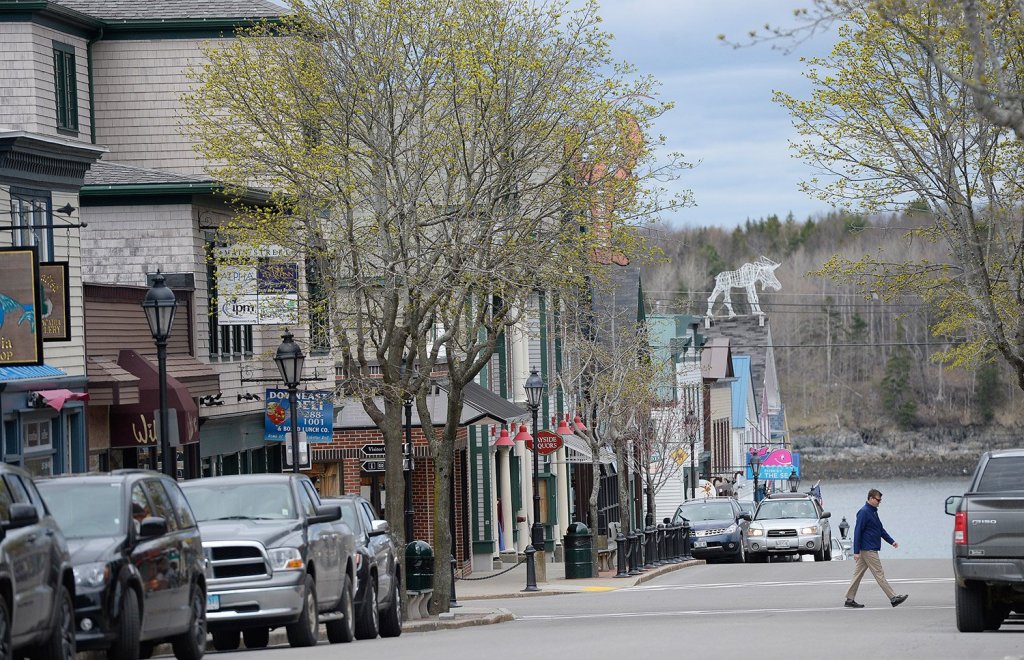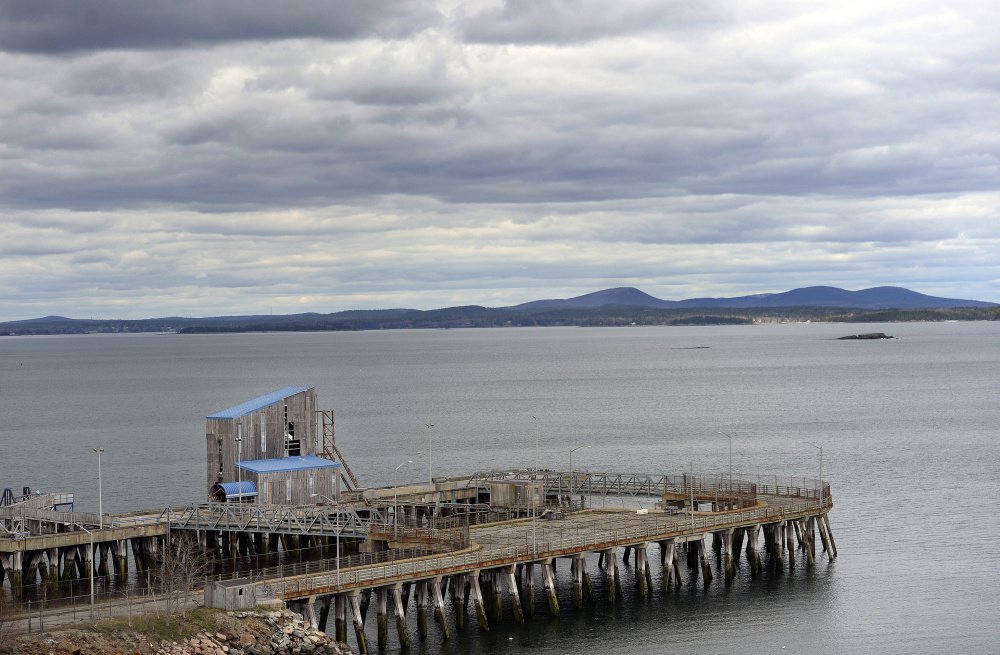BAR HARBOR — Pleasure boats and sea gulls bob in the water of Bar Harbor, which owes its existence to throngs of summer tourists and its proximity to Acadia National Park.
For decades, the town on Mount Desert Island has laid out a welcome mat for millions of visitors who come to enjoy its shops, restaurants and outdoor activities.
But a controversy is brewing among its residents, one with potential repercussions for both its economy and quality of life. On Bar Harbor’s ballot Tuesday are two competing zoning measures concerning the future of an abandoned ferry terminal. One question, drafted by the town, paves the way for a rehab of the terminal and construction of a pier that could more than double the number of cruise ship passengers the town hosts. The other, put on the ballot through a citizens petition, embraces the status quo, limiting the size of ships that could dock at the terminal and curtailing the town’s ability to increase cruise ship visitors.
Swirling around the two measures is a nasty campaign, Facebook battles and a flurry of political advertisements that lay an ugly patina on the town’s typically folksy reputation.
“I don’t recall this many outright lies to get people to change their minds,” said Jeff Dobbs, a member of the town’s cruise ship committee who supports the town’s proposal. “Other than a national election, this is the worst one I’ve seen for a long time.”
At the heart of the issue is a disused terminal outside downtown Bar Harbor used for a ferry service between Maine and Nova Scotia that ended in 2009, after more than 50 years of service.
After the ferry service ended, Bar Harbor hired Bermello Ajamil and Partners Inc., a Miami-based developer specializing in maritime projects, to perform a feasibility study on the pier. In a 200-page report released in 2012, the firm concluded the best use for the property was as a ferry terminal and cruise ship pier.
The report noted that as cruise ship lines build and sail larger ships, they increasingly avoid ports like Bar Harbor that require tendering – ferrying passengers from ship to shore – which is expensive and time-consuming.
But whether residents want more cruise traffic and the thousands of visitors it may bring is at the nub of the debate.
With a new pier, the Ajamil report projected the number of cruise visitors could increase from roughly 160,000 to a target of almost 450,000 by 2032. Without the improvements, the town could see a long-term drop in cruise business, it warned.
“We are not trying to dictate anything, we are just trying to give voters control of what happens in town, so it is not controlled by two or three people,” said Barbara Fenderson, a resident who helped organize the citizens ballot issue. “This is not a political campaign; this is a bunch of people trying to save Frenchman Bay.”
CRUISE BUSINESS
Bar Harbor is the biggest cruise destination in Maine. Traffic has grown 35 percent since 2003, from 78 ships to 105 last year, with 163 ships projected this year, according to CruiseMaine. Cruise ships had a $20.2 million economic impact in Bar Harbor in 2016, a 67 percent increase from 2003, according to twostudies from the University of Maine.
Downtown merchants and restaurants say cruise passengers are especially important in the fall, after summer tourism tails off. John Bench, manager of the Cool as a Moose store on Main Street, said before the town became a major cruise destination, his season started around Memorial Day and ended after Labor Day. Now the store is open from April until the end of October, he said.
“It’s easy to think we could just survive in June, July and August, but we can’t,” Bench said.
Tourism is the economic backbone for Bar Harbor, which has about 5,235 year-round residents. More than 3 million people visited Acadia National Park in 2016, and many likely stopped in Bar Harbor. Cruise ships only account for 5 percent of Bar Harbor’s annual tourist traffic, but they have an outsized influence on debates about congestion and overcrowding, said Martha Searchfield, executive director of the Bar Harbor Chamber of Commerce.
“Somehow it seems this has become the focus, but the numbers don’t really bear it out,” she said.
Leon Debbah, owner of Debbah’s gift shop, a Main Street institution, said cruise ships are critical to his business and he hopes the town improves its cruise infrastructure.
“Without cruise ship business, I wouldn’t be here,” Debbah said, noting that cruise ships will head to other ports if they don’t have adequate infrastructure.
In order to grow cruise ship traffic, the ferry terminal needs to be upgraded. The preferred concept for a pier in the Ajamil report showed a fixed pier up to 1,555 feet long that could service 850-to-1,000-foot-long cruise ships. Concept renderings in the report showed two large ships docked at the pier simultaneously.
Town officials stress there is no formal business plan for the project, but the estimated cost of an updated cruise ship terminal is $30 million.
In its current configuration, tendering passengers creates traffic and pedestrian congestion downtown and cuts into the time passengers spend on shore, and, consequently, how much money they spend in local shops, restaurants and on excursions. Separately, the town expects to earn about $800,000 in cruise ship fees this year.
The town already has daily passenger caps: 3,500 people a day in the summer and 5,500 a day in the spring and fall, when most cruise ships dock in town.
Town Manager Cornell Knight said a new cruise terminal would alleviate the congestion downtown and make unloading passengers more efficient, but he doesn’t think it would mean a massive increase in the number of passengers coming into town. The plan is to make a cruise pier work with existing caps in place, but that might change depending on how much the project costs, Knight said.
“It might be that we can do the project within the limits we currently have,” he said.
OPPOSING VOICES

Barbara Fenderson at the unused ferry terminal that could potentially be converted to a large berth for large cruise ships in Bar Harbor Wednesday, May 3, 2017. Fenderson would like local voters to have more input in the project. Staff photo by Shawn Patrick Ouellette
Opposition to a cruise ship pier has been fierce, despite town officials’ assurance no formal plan exists and any project would be developed with full community input.
Alarmed residents of Bar Harbor and nearby communities have raised the specter of a “mega-pier” extending almost a half-mile into Frenchman Bay for massive cruise ships that will bring tens of thousands more tourists, pollution and destruction of the island’s natural scenery. If the town’s zoning proposal is approved, a cruise ship pier is a foregone conclusion, they warn.
“This is a horrendous decision for the town to make with serious environmental consequences,” said Arthur Greif, a resident and attorney who drafted the citizens initiative. “This will destroy the visitor experience for Acadia National Park.”
Fenderson said her concern is that the town’s referendum question, called Article 12, amounts to a give-away for the cruise industry and would take decision-making out of the hands of citizens. She and others supported an opposing measure, Article 13, that allows development at the terminal but limits the length of ships docking there to 300 feet, and mandates any change to passenger caps must be approved by voters. Supporters say that would be enough for a moderate cruise ship terminal and tender point and could be amended in the future. But Knight said it would effectively be a moratorium on docking large cruise ships, which account for about 90 percent of the town’s traffic.
The opposition has led to a range of allegations, including that town officials are in the pocket of consultant Luis Ajamil and the cruise ship industry. Ajamil did not respond to interview requests.
“There has been this willful refusal to look at the man behind the curtain,” Greif said. “The town manager and the Town Council chair have listened to Luis Ajamil; they have not listened to the voter.”
The town is plastered with political signs and a pro-Article 13 group has sent rounds of mailers and taken out full-page newspaper ads. One poster shows the image of a large, hulking cruise ship dwarfing the Bar Harbor municipal building, implying that the ship’s more than 8,000 passengers will overrun the town at once. On Facebook, that same poster is stamped “Scare tactic” with an accompanying note that a cruise ship that size wouldn’t be allowed to call on Bar Harbor because it exceeds the daily passenger limit. That inspired posts about “underhanded tactics” and people having a “head stuck in your butt.”
Town Council Chairman Paul Paradis said he has been disappointed with the tenor of the campaign.
“I’m a guy that likes different points of view, but I don’t think there is a place for dishonesty and groundless accusations,” said Paradis. He feels that the council and Ajamil, among others, have been accused of an unfounded conspiracy.
“The Town Council are all people of integrity and people who work hard for the town,” he said. “It is disheartening that folks would accuse those people of dishonesty and impropriety without grounds.”
Greif, who has sued the town multiple times over land issues and has ongoing litigation against the town government, denies he or the Article 13 group have misled voters.
“All the town keeps saying is we are not there yet for a half-mile pier, but they are headed there at 100 miles an hour,” he said.
LAYING A FOUNDATION
The outcome of Tuesday’s vote will determine whether the town will even have the option to purchase the abandoned ferry terminal. The Maine Department of Transportation bought the property from the Canadian government in February for $3.5 million, using a state transportation fund. An agreement signed with the town in May gives the town until November to buy the parcel for $2.5 million. If Bar Harbor has a business plan approved by the MDOT in place, the price drops to $2 million. Bar Harbor residents would vote on the purchase in June 2018.
But the agreement will automatically terminate if voters approve Article 13, called a “cruise ship moratorium” in the agreement. If the parcel isn’t developed within five years, the state can retake control and sell it on the open market.
The state bought the property to help Bar Harbor manage cruise traffic, said Deputy Commissioner Jonathan Nass. If voters curtail cruise traffic, then there is no need for the property, he said.
“We aren’t going to force it on them and will seek other uses for the property,” Nass said.
If the agreement terminates, the department won’t negotiate another one, he added.
Peter McGuire can be contacted at 791-6325 or at:
pmcguire@pressherald.com
Send questions/comments to the editors.










